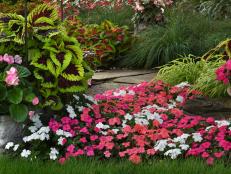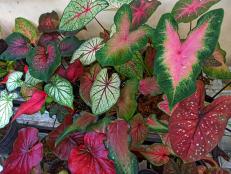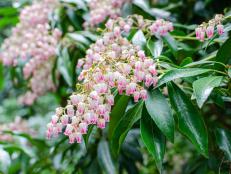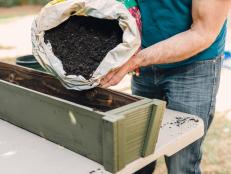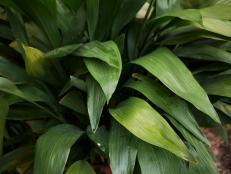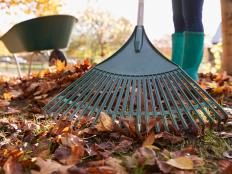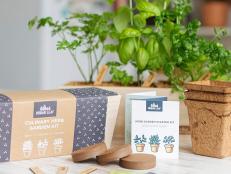Shade Gardening Secrets

Every yard plant requires some degree of sunlight to grow properly. The most common and familiar plants require full sun, which means eight hours or more of sun a day, or partial sun, which means four to eight hours of sun.
A garden spot that gets fewer than four hours of sun a day cannot grow full- or partial-sun plants. If the shade is the result of a north-facing exposure, a high roof-line or overhanging eaves, there's not much that can be done to get rid of it. If the shade is cast by trees, more sun can be created by limbing them up (that is, by removing low-growing branches) or by selectively thinning out the canopy to let more light in. It is almost always cheaper and easier, and very often smarter, to adapt a plant to these conditions rather than the other way around.
Shade can vary dramatically during the day and throughout the year. For instance, when deciduous trees are dormant, the area beneath them gets full sun, but once the trees leaf out in spring, that same area may get no sun at all.
Soil
Soil is the secret to growing plants successfully in the shade. On the forest floor, there is a layer of leaf litter. The soil itself may be surprisingly thin, but that's okay so long as the leaf litter is there. These conditions can be re-created at home, and to do that, mix shredded leaves with compost or packaged products containing a fair amount of something called leaf mold, which is merely partially composted leaves.
If the soil in a shady garden site is decent, then all you need do is add the shredded leaves and compost to each plant's planting hole. Top that off with a thick layer of mulch, and plants should do just fine provided they remain evenly moist.
Remember that soil conditions can vary widely in shady spots. In time, by adding several inches of finely shredded leaves around the base of a tree, the soil conditions needed to support the growth of numerous shade-tolerant plants, even turf grasses, will be created. It may take awhile, perhaps a year or two or three, but it's the second-best solution to the problem. The best solution is to plant something that grows in dry shade, such as English ivy or Japanese pachysandra, both of which are easy to find and grow.
Shade-Tolerant Plants
Among trees, the best shade-tolerant types are the dogwoods, true understory trees that grow in the wild beneath the shade cast by much larger trees. The most common dogwood is the native Cornus florida, and it's a great tree. An Asian variety, Cornus kousa, flowers about a month later and thrives equally well in shady spots. Japanese maples also do nicely in all but the densest shade. But the red varieties may not color up as well without a few hours of sun, preferably morning sun.
When it comes to shrubs, the list includes short, tall and medium plants, as well as deciduous and evergreen varieties. Azaleas and yews are popular types, and within the world of perennials the best-known example is the hosta.
Hardy ferns of all kinds are easy to grow. One favorite is the cinnamon fern, so named because of its distinctively colored new fronds. The columbines are a favorite among shade-loving flowers. Siberian iris, like the daylily, isn't often thought of as a shade-tolerant plant, but it does beautifully with only an hour of sun a day. Another of my favorites is the Dicentra. The common name of this plant is bleeding heart, because of the shape of its flower. Finally, there's astilbe, which produces gorgeous fernlike foliage that's hard to beat.
Preferred Shade-Tolerant Plants:
Annuals
Begonia, Coleus, Impatiens, Forget-Me-Not (Myosotis sylvatica), Pansy (Viola)
Perennials
Astilbe, Bleeding Heart (Dicentra), Bugbane (Cimicifuga), Campanula, Columbine (Aquilegia), Coral Bells (Heuchera), Foxglove (Digitalis), Goatsbeard (Aruncus), Helleborus, Daylilies (Hemerocallis), Hosta, Virginia Bluebells (Mertensia virginica), Ferns (all kinds), Monkshood (Aconitum), Phlox, Primrose (Primula), Lungworts (Pulmonaria), Cardinal Flower (Lobelia), Siberian Iris, Veronica
Ground Covers
Ajuga, Wild Ginger (Asarum), Sweet Woodruff (Galium odoratum), Epimedium, English Ivy (Hedera helix), Lamium, Liriope, Mondo Grass (Ophiopogon), Pachysandra, Spirea, Vinca
Shrubs
Boxwood (Buxus), Daphne, Gold Dust (Aucuba), Holly (Ilex), Hydrangea, Mountain Laurel (Kalmia latifolia), Kerria, Leucothoe, Oregon Grape (Mahonia), Mock Orange (Philadelphus), Nandina, Privet (Ligustrum), Cherry Laurel (Prunus laurocerasus), Rhododendron (including Azalea), Viburnum, Yew (Taxus)
Trees
Dogwood (Cornus), Japanese Maple (Acer palmatum), Stewartia






